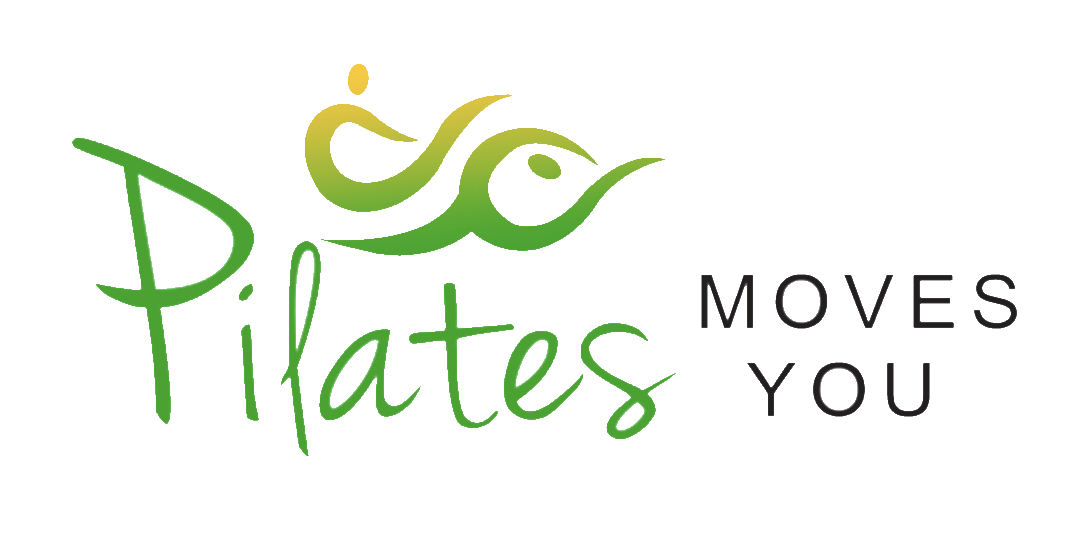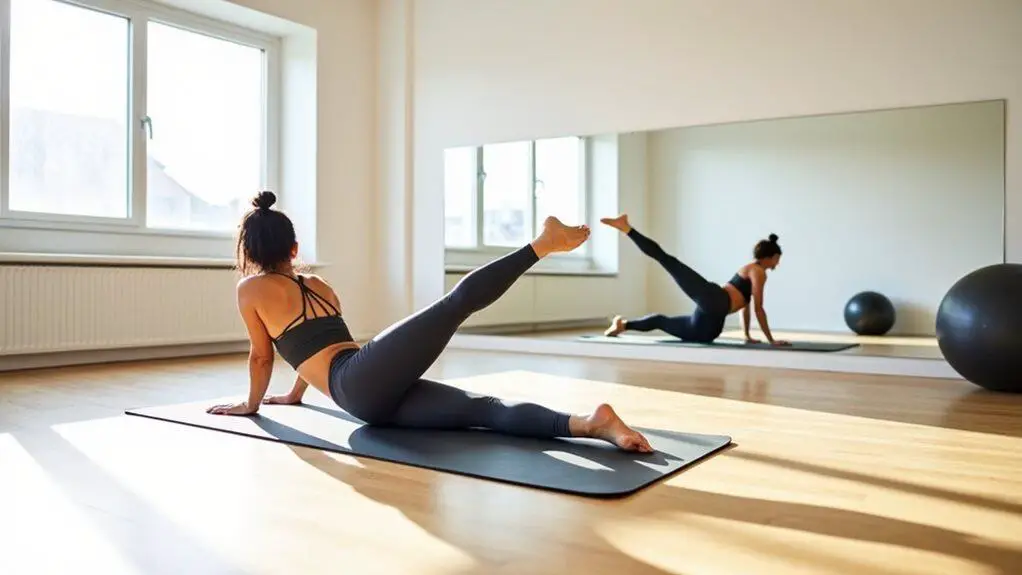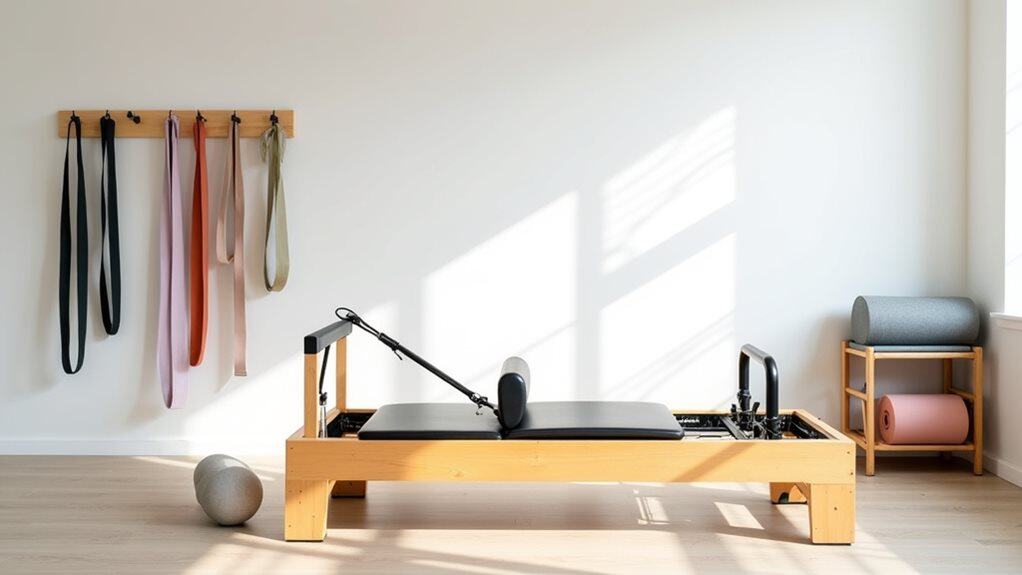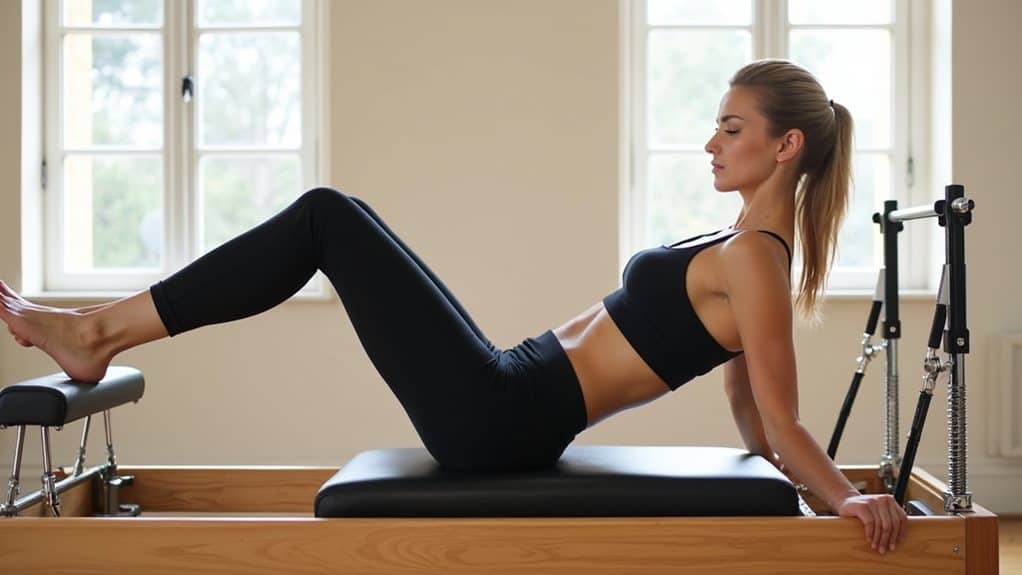If you’re like most people, you’re always looking for ways to get in better shape without having to spend hours at the gym. When people visit my studio for the first time they see various items of equipment, with eyes usually drawn to my Pilates reformer, which is a very large item, and they are concerned they’ll have to make a big investment into a similar Pilates machine for home use. Can you do Pilates without a machine?
Yes, you can do Pilates without a machine! In fact, many people choose to do Pilates exercises without any equipment at all. Pilates is a series of controlled movements that engage the core, and these moves can be done with nothing but your body weight and a mat.
If you’re just starting out, I recommend booking some time in with a professional instructor who will assess your existing fitness level and core strength before demonstrating the basic concepts that you can then do at home.
There are plenty of great videos online that can show you how to get started, including my own YouTube channel.
Once you’ve gotten the hang of things, you may want to consider adding some equipment to increase the challenge of workouts and add variety to keep you interested.
But the bottom line is that you don’t need any special gear to do Pilates – just your own body and some determination!
Pilates: What is it?
If you’ve never been to a class you might be wondering what Pilates and what it involves. Essentially Pilates is a form of exercise that has been around for a long time and it is low-impact way of working out the entire body, with a specific focus on the core muscles.
Pilates focuses on precision and proper technique, which can be difficult to do when you start, but gets easier the more you practice. Unlike some workouts, many Pilates moves are not limited to specific body parts- you can engage your arms, glutes, and lower legs as you work through the exercises.
The focus of Pilates is on the entire trunk of the body instead of just your an area such as abs. Instructors often mix in moves specifically meant to engage other areas like your arms, glutes, and lower legs which makes a full-body workout possible. If you are looking for a challenging but low-impact workout, Pilates may be perfect for you!
Pilates benefits
There are a LOT of benefits, and each individual will take something different from a regular class. Many people do Pilates because of benefits, such as improving posture, flexibility, and mobility. Others like it because it helps increase strength in the upper body and stability. In addition, Pilates can help with mental endurance.
The exercises in a Pilates class are not as intense as other workouts, but they can still be very effective. The moves should be modified to create good form and avoid injury.
Sore muscles after your first week of Pilates mean you are challenging yourself and getting stronger on the mat!
To learn more about the amazing benefits, see: The many benefits of Pilates
Is no equipment Pilates effective?
As an instructor I’ve become use to people assuming that exercise requires equipment, after all, you pay to use a gym and access to all the expensive machines they have. The thinking being that exercise without equipment can’t be effective.
Pilates without any equipment is effective in toning muscles and strengthening them. Your body is all you require to provide the resistance for an effective workout.
Many people choose to do Pilates without any equipment because it’s a great way to get in shape and strengthen your body.
That’s not to say using equipment doesn’t enhance a workout, it can add an extra challenge and make you stronger than using body weight alone, it just means you don’t need any special tools or machines to do Pilates effectively.
You can use nothing more than your own body weight and a mat. In some workout I’ve even suggested the use of common household objects instead of specialist equipment, for example use food tins instead of hand weights.
One thing that makes Pilates so popular is that it’s easy enough for anyone to do–regardless of age or fitness level. You can practice Pilates at home with relative ease, and it’s generally a low-intensity exercise, so you won’t get too sweaty.
In fact, many people choose to do Pilates in their living rooms because it’s convenient and doesn’t require any special equipment or space. So if you’re looking for a great way to stay in shape, give Pilates a try!
Can you teach yourself Pilates at home?
Yes, you can teach yourself Pilates at home. The best way to do this is by using videos, so you can see the full movement and listen to the instructions given.
There are lots of videos available on sites like YouTube (where you can find my FREE channel!), or you could opt to purchase an online course, which are usually more structured and focused than YouTube channels.
Please do keep in mind that if you’re a beginner who has never done Pilates before it is a good idea to seek out professional help to understand the basics and reduce the chance of injury.
Pilates without machine: How to do it
Pilates is a great workout to do at home, and there are plenty of methods to practice without any equipment. Here are some tips:
Breathe Properly
If you attend any class or watch any videos you’ll often hear the instructor telling you to breath in and out. Breathing properly is important for exercising safely. If you hold your breath, you may injure yourself.
To breathe correctly, inhale deeply through your nose and exhale through your mouth. Inhaling through your nose allows air to enter your lungs, while exhaling through your mouth allows oxygen to leave your lungs.
Breath out when there is effort, breath in when there is relaxation. This will allow you to control your breathing and avoid holding your breath.
Use A Mat
It is perfectly possible to do Pilates without a mat (see: Can I do Pilates without a mat?).
However, using a mat is recommended as it provides stability and prevents injuries. This is especially important when working out at home to ensure you’ve got a supportive surface underneath you.
Fortunately, mats are not very expensive to purchase and they tend to last so are a good investment to make. Just make sure you don’t purchase a yoga mat, they look similar online but do not provide the same support as a thicket Pilates mat.
Don’t Overdo It
Taking up a new activity can be exciting, and Pilates is certainly something you can become addicated to, I can personally vouch for that!
Don’t try to perform too many exercises at once, and don’t try complex moves until you’re comfortable with the basics.
This is where professional instruction is a very beneficial, an instructor will adapt your workout for your curent level and ensure you don’t go too far.
Whatever stage you’re at, learning the correct technique for your level means you can complete a full-body workout in 15 to 20 minutes.
Get Help From A Professional
I’ve mentioned this a few times but this is really one of the best tips I can give you. Even if you want to learn Pilates at home it is important you learn how to do them safely and correctly.
The best way to gain a solid foundation is to consult a professional trainer. I don’t mean someone who happens to do Pilates, I mean someone who has been supervised and assesed as being competent to train others in the safe and correct way.
Exact qualifications differ depending on where in the world you are, but checking the instructors website should tell you the qualifications they have.
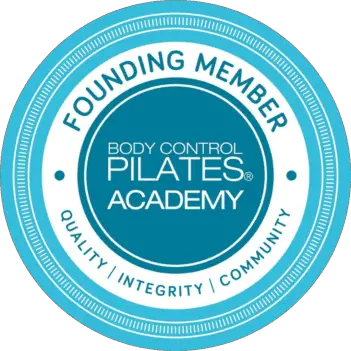
As well as asking friends and family if they recommend anyone, you could also check in with your doctor to see if they know a qualified professional.
With all that in mind, give this workout a try:
Pros and cons of doing Pilates without a machine
I love all forms of Pilates, it’s part of my everyday fitness routine and I enjoy teaching it to my clients. All Pilates practice will help with your postural alignment, give you toned muscles, and general improve your quality of life, so what’s the deal with using machines?
As someone who loves the Pilates reformer, let me tell you about some of the many benefits of doing Pilates without a machine:
- Low cost – all you need is a mat and space to work out;
- Do it anywhere – no equipment means you can do Pilates literally anywhere there is space;
- No storage space – not having to store lots of equipment is a big plus for those with limited space;
- Accessible – not having to learn how to use specialist equipment makes Pilates easily accessible to everyone, no matter the age, fitness level or experience.
Of course these contraptions wouldn’t exist if they didn’t have their own set of benefits:
- Challenge – Using equipment can help to make your Pilates workout more challenging, helping you to achieve better results in a shorter amount of time;
- Adjustable – It can be easier to track your progress over time because as you progress you can adjust the settings to increase the difficulty.
- Gentle on joints – Unlike some exercise machines the reformer doesn’t involve any impact on joints, which also makes them great for those recovering from injury.
- It can be fun – It can be daunting to learn how to use a new piece of equipment, I have so much fun learning to understand how to get the best out of my reformer.
The reformer is a great piece of exercise equipment but not something to take on without any experience. Given how much they cost, I recommend heading to a reformer class to learn how to correctly use one before considering an investment.
Which is better for you-machine or no machine?
There are a lot of benefits to Pilates-whether you’re doing it on a machine or not. I find that many people prefer to do Pilates without machines to start with because there is a lot to learn.
Once you become proficient the introduction of equipment can make your workouts more challenging and engaging.
That’s one of the things I love about Pilates, it’s flexible enough that both options offer great results.
